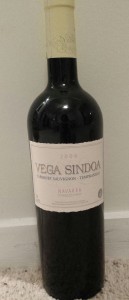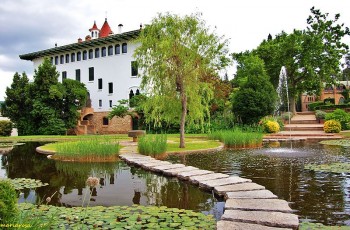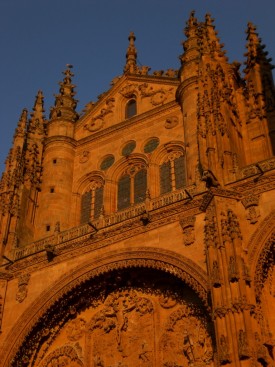
 I admit that on my last trip to Spain, I pretty much just drank sangria (and ate ice cream) which means other than the fact that it was red, I had no idea what wine I was drinking. On my next trip to Spain, I hope to be a little more sophisticated, so I’ve done some preliminary research
I admit that on my last trip to Spain, I pretty much just drank sangria (and ate ice cream) which means other than the fact that it was red, I had no idea what wine I was drinking. On my next trip to Spain, I hope to be a little more sophisticated, so I’ve done some preliminary research
I often think of Spain as desert and mountains, so I was surprised to learn that Spain has more acres under grape vine cultivation than any country in the world. In 2013, thanks to a year of excellent weather conditions, Spain surpassed both France and Italy in wine production.
There are several Spanish micro-climates, so a wine tourist can visit vineyards with diverse, picturesque landscapes scattered across the country. Each region has something unique to offer wine connoisseurs. On my first Spanish wine trip, I hope to visit several of these regions:

Vista from Castillo de Clavijo in La Rioja. (Photo credit: Wikimedia Commons Gurrea CC lic. 4.0)
- La Rioja
The region of La Rioja is located in mountainous central northern Spain, just south of the Basque region. Some refer to it as “Spain’s Tuscany”. From a wine perspective, it is divided into three regions, but all are known for rich, dry red wines. There is archaeological evidence that Phoenicians first produced wine in La Rioja in the 11th century B.C., a tradition continued after the Roman conquest and through medieval times to the modern era. La Rioja was the first Spanish wine region to be awarded special regulatory status in 1991 when it was officially recognized by the Spanish government as a premier wine region. Its largest city is its capital Logroño from which one can arrange wine tours to lovely mountain hamlets.
- Penedes, Catalunya (Catalonia) Spain

Casa Pairal, Caves Codorníu, Sant Sadurní d’Anoia, Catalunya (Photo Credit: Maria Rosa Ferre, CC Lic. 2.0)
I wish I had started my wine research during my recent trip to Catalunya. At least I was introduced to cava while there, a wine that is this region’s version of “champangne”. (I’m sure the vintners who produce cava would tell you that champagne is the French version of cava.) I even tried cava sangria. Yum. If you have been buying and enjoying Tesco Cava Brut, at home, you can visit Codorníu, the winery that produces this sparkling white wine. Indeed, Codorníu started producing cava in 1551, long before big box stores were even a thing. The Codorníu winery is located in Sant Sadurni d’Anoia, 50 kilometers west of one of my favorite cities in the world, Barcelona. There are also some 59 other cava producers in the region which can be reached by train. Alternatively, one can easily book a day tour to the region from Barcelona to visit several cava wineries. Tours of Codorníu have stellar reviews on TripAdvisor.
- Ribero del Duero
The Ribero del Duero wine region is located west of La Rioja in the large northern plateau of Spain, about two hours driving time from Madrid. Although it includes parts of four provinces of Castilla y León: Valladolid, Burgos, Segovia and Soria, it’s best known wineries are in the western part of the area known to wine connoisseurs as “the Golden Mile” (la milla de oro), along the Duero River valley. While visiting this wine region, I’ll be able to revisit the Spanish cities of Segovia and Salamanca between wine tastings.
- Jerez de la Frontera
A wine tour of Jerez de la Frontera will give me the chance to visit the Spanish southern autonomous region of Andalucia and the municipality of Cádiz. Jerez de la Frontera is best known as the world capital of sherry, a fortified wine made from white grapes, popular with the British (and my mother). Although this region saw wine making as long ago as the Phoenician settlement in 1100 B.C. and through the Roman period, it was actually the Moors who introduced the distillation method that produces brandy and fortified wine in the 8th century. This region has jumped on the enotourism bandwagon and sherry enthusiasts can find many tours that follow the Route of Sherry Wine and Brandy.
Mr. Excitement has managed to land himself a speaking gig in Madrid in early December. With my new found wine knowledge, while he’s working, you can probably guess where you’ll find me.
[This article is posted in collaboration with Leona S. Green of Interactive Media].



{ 16 comments… read them below or add one }
I’ve had some good Spanish wines, though I must admit none come to mind at this moment! What an interesting trip, however! The photo of the cathedral in Salamanca, Spain is stunning! I’ll be looking forward to your thoughts on Madrid and the wines you expereince there…and the ice cream, too:)
Cava was a new experience for me on this trip. I don’t know how I’ll do with all the Spanish red wines. Red wine usually gives me a headache—but that’s why they invented ibuprofen, right?
In bed nursing a hangover?
Just kidding. I’m sure we’ll find you knowledgeably sipping something delicious.
Lucky you, traveling to Spain in December! I’ll think of you as I’m shoveling snow back in Philly.
It can actually be quite chilly in Madrid in December although I don’t expect to be shoveling snow, but with climate change, who knows.
I had no idea you had Tesco in the US? I guess those guys are everywhere these days, just like we have Walmart (Asda) in the UK.
I’ve never really been much of a wine drinking (hence the lack of my drinking hardly anything at TBEX), but during our trip around the Priorat region we took following the conference I did happen to try a few wines that were vegan and was completely blow away. Possibly the best wine I’ve even drank anywhere, ever.
Utterly jealous of your trip to Madrid, by the way. One of my favourite cities in Europe.
Um, actually, TESCO pulled out of the US and in Pennsylvania supermarkets can’t sell wine. My collaborator for this post is UK based. Why isn’t all wine vegan?
I like Cava better than Champagne! It’s less fizzy so I felt like it went down easier (which also meant I drank too much of it!). What I liked best, though, was the Rioja. It had a wonderful rich taste. I’m going there again in October, and I’ll make sure to test out wine from each of the different wine regions of Spain this time.
Hi Suzanne, I wish I could travel to Spain for an exciting trek through some of the wine regions. On my one and only visit to Spain it was a short day trip and I didn’t have a chance to visit any of the wine regions. It’s definitely on my ‘bucket list’. Thanks for sharing this terrific info.
Hi Suzanne,
Thank you for pointing out the importance of Spain’s wine industry — and so glad you had a chance to experience their unique country by way of TBEX earlier this year. Barcelona is indeed fantastic, yes?!
The Penedes region of Catalonia is where Conrad and I have spent many months, and have toured Codorníu and other spectacular wineries. We go back again in October. Can’t get enough!
Wishing you a safe and happy journey to Madrid in December,
Josie
Thank you, Josie. Now I wish I had done more wine drinking in Catalunya when I was there earlier this year!
As you know we were in Spain for nearly 6 weeks and as you also know we spent 5 of those weeks walking the Camino. The only thing that drove Abi bonkers was the chilled red wine. By the time we left Spain he decided he had grown accustomed to it, but was morally opposed to the concept of chilled red wine. 😉 I, on the other hand, am not a drinker of red wine, unless, it’s a glass of sangria. Then, I can’t get enough of the stuff and in Portugal I discovered Port Sangria. Hello!
Ahh. Cold sangria on a hot day. It goes down mighty easy.
I don’t think I have drunk a Spanish wine for many years. You have made we want to go and buy one.
Dear Suzanne, I LOVE red wines of all types, but I’ve not had many from Spain (here in Arizona the New Zealand choices overwhelm in my budget; less expensive than most California wines, which are just over there from here…) I dont know if you have a Total Wine near you, but they do tastings here on Fridays and Saturdays and have been advertising Spanish wines this month. It’d be a very cost-effective education.
Have a brilliant day! c
Thanks for the Spanish wine 101 lesson :-). Cava, prosecco, champagne – all go down smoothly for us… Your Madrid trip sounds exciting! Lots of terrific museums we understand. But you have to dine late – nothing opens until after 9:00 pm, we hear.
There’s a theme in your favorite wines. I take it you like bubbles. 🙂
{ 1 trackback }